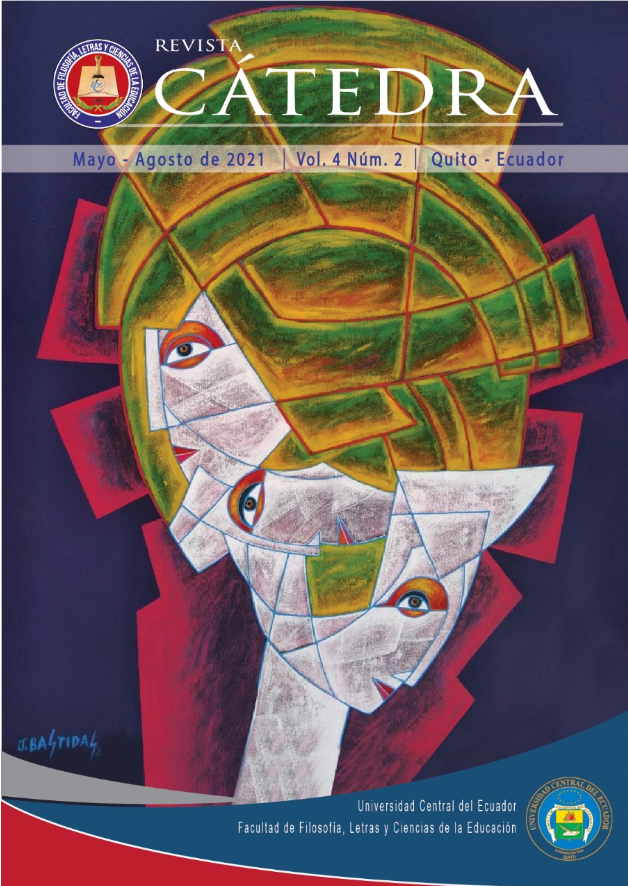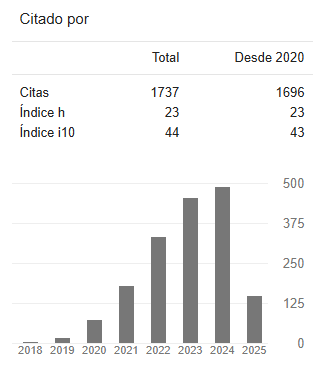Perception about textbooks in math teaching-learning of Mathematics
DOI:
https://doi.org/10.29166/catedra.v4i2.2930Keywords:
curriculum, evaluation, learning objectives, Math, school texts, teaching-learningAbstract
Textbooks are a necessary resource in the science teaching-learning process and should consider, among others, the curricular elements: learning objectives, mathematical content and evaluation. The purpose of this research is to determine the level of satisfaction that the development of these elements generates in students and teachers, expressed in these textbooks used in the Ecuadorian educational system. It should be noted that the Ministry of Education provides this school material free of charge to all public institutions in the country and, therefore, motivates research on its application and use. This study has a quantitative approach and is exploratory and descriptive, so an observation instrument was used for data collection. The results are expressed by levels of schooling of both the General Basic Education sub-level and the General Unified Baccalaureate and by the curricular elements studied. Finally, it was concluded that the objectives proposed for the Unified General Baccalaureate have a higher level of satisfaction than those declared for General Basic Education. It was also concluded for both levels that there is a medium level of satisfaction with the elements investigated in the textbooks, which means that the students who use them are not oriented to continue with more complex learning.
Downloads
References
Araujo, B. (2009). Planificación y ciclo de aprendizaje. Santillana.
Arribas, J. (2017). La evaluación de los aprendizajes. problemas y soluciones. Revista de Currículum y Formación de Profesorado, 21(4), 381-404. https://www.redalyc.org/pdf/567/56754639020.pdf
Campanario, M. (2001). ¿Qué puede hacer un profesor como tú o un alumno como el tuyo con un libro de texto como éste? Una relación de actividades poco convencionales. Enseñanza de las ciencias: revista de investigación y experiencias didácticas, 19(3), 351-364. https://www.raco.cat/index.php/Ensenanza/article/view/21753/21588
Choppin, A. (1993). L’histoire des manuels scolaires. Un bilan bibliométrique de la recherche française. Histoire de l’Éducation, 58(1), 165-185. https://www.persee.fr/docAsPDF/hedu_0221-6280_1993_num_58_1_2663.pdf
Constitución de la República del Ecuador. Art. 28. 20 de octubre de 2008 (Ecuador).
Creemers, B. (1991). Effectieve instructie. Een empirische bijdrage aan de verbetering van het onderwijs in de klas. Den Haag, Instituut voor Onderzoek van het Onderwijs.
Duque, R. (1993). La evaluación en la ES Venezolana. Planiuc.
Eyzaguirre B. y Fontaine L. (1997). El futuro en riesgo: nuestros textos escolares. Estudios Públicos, 68(1), 339-354. https://www.cepchile.cl/cep/site/artic/20160303/asocfile/20160303184453/rev68_eyzaguirrefontai.pdf
Fernández, J. (2010). La resolución de problemas matemáticos: creatividad y razonamiento en la mente de los niños. Grupo Mayéutica Educación.
Fernández, M. y Caballero, P. (2017). El libro de texto como objeto de estudio y recurso didáctico para el aprendizaje: fortalezas y debilidades. Revista Electrónica Interuniversitaria de Formación del Profesorado, 20(1), 201-217. https://dialnet.unirioja.es/descarga/articulo/5969918.pdf
Flotts, P., Manzi, J., Barrios, C., Saldaña, V., Mejías, N. y Abarzúa, A. (2016). Aportes para la enseñanza de la matemática. Unesco. https://unesdoc.unesco.org/ark:/48223/pf0000244855
García, A. (2014). El uso del libro de texto de matemáticas en el aula. Universidad de Granada. https://digibug.ugr.es/bitstream/handle/10481/36188/GARCIAMARTINANTONIO.pdf?sequense=1
Ministerio de Educación del Ecuador. (2016). Matemática 3 BGU. Editorial Don Bosco.
Nortes, A. y Nortes, R. (2011). Los libros de texto y la resolución de problemas en la enseñanza-aprendizaje de las matemáticas. Educatio Siglo XXI, 29(2), 67-98. https://revistas.um.es/educatio/article/view/132981/122681
Obaya, A. y Ponce, R. (2007). La secuencia didáctica como herramienta del proceso enseñanza aprendizaje en el área de Químico Biológicas. ContactoS, 63(1), 19-25. http://www2.izt.uam.mx/newpage/contactos/anterior/n63ne/secuencia_v2.pdf
Parcerisa, A. (1996). Materiales escolares: cómo elaborarlos, seleccionarlos y utilizarlos. Grao.
Puente, D. (2016, 18 de julio). Matemática, el dolor de cabeza de los bachilleres de Ecuador. El Comercio. https://www.elcomercio.com/actualidad/matematica-serbachiller-ecuador-educacion-estudiantes.html
Salcedo, H. (2011). Los objetivos y su importancia para el proceso de enseñanza-aprendizaje. Revista de Pedagogía, 32(91), 113-130. https://www.redalyc.org/pdf/659/65926549007.pdf
Standaert, R. y Troch, F. (2011). Aprender a enseñar. Manthra.
Van Bruggen, J. (1987). Leermiddeleninformatie en leerplanontwikkeling. Notitites van en voor leerplanontwikkelaars, 7(3), 133-141.
Velásquez, M. (2019). El Diferendo por el Territorio Esequibo en los Textos Escolares Venezolanos y Guyaneses [tesis doctoral, Universidad Católica Andrés Bello]. Repositorio Institucional UCAB. http://biblioteca2.ucab.edu.ve/anexos/biblioteca/marc/texto/AAS9972.pdf
Villardón, M. (2006). Evaluación del aprendizaje para promover el desarrollo de competencias. Educatio Siglo XXI, 24(1), 57-76. https://revistas.um.es/educatio/article/view/153/136
Downloads
Published
Versions
- 2021-10-21 (2)
- 2021-05-26 (1)









